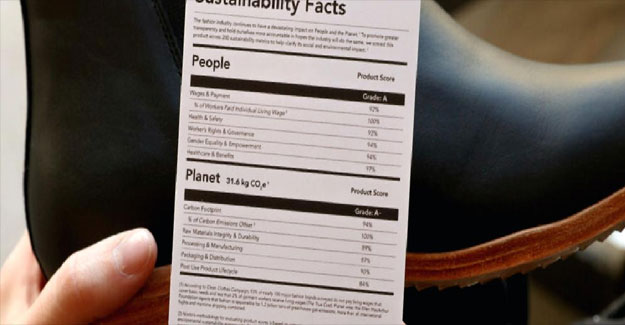
What If You Could Read A Fashion Label Like A Food Label?
It was in December that Nisolo, a sustainable shoe brand in Nashville, Tennessee, introduced what may be the most familiar-looking label of all: a “Sustainability Facts” label inspired by the nutrition facts box on many food products. One of the biggest fashion trends of late 2021 didn’t have to do with colour or skirt length or sequins but rather with sustainability. Or, to be specific, the appearance of clothing labels with data that consumers can use to trace the creation of a potential purchase. The roots of the trend stretch back to 2019 at least, when Sheep Inc., a knitwear label in London, introduced an NFC tag — or near-field communication (the same tech that enables contactless payment) attached to its sweater hems — that allows customers to track the supply chain of its Merino wool sweaters via an app. At the Group of 20 meeting in October 2021, Prince Charles’ Sustainable Markets Initiative Fashion Taskforce presented its “Digital ID,” which can trace a fashion item from production through sale and even resale. It will be used by the Taskforce’s 15 brands and retailers including Armani, Mulberry and Chloé this year before becoming more widely available. And the British startup Provenance developed software to trace the supply chain of pieces from field to finished garment. Provenance’s technology was first used last fall by Ganni, a Danish brand. It was in December, however, that Nisolo, a sustainable shoe brand in Nashville, Tennessee, introduced what may be the most familiar-looking label of all: a “Sustainability Facts” label inspired by the nutrition facts box on many food products. For years, clothing labels have offered straightforward information like the country where the item was made, and its material composition by percentage, the size, and care instructions. But if it’s a cotton T-shirt, that labeling doesn’t explain anything about, say, where and how the cotton was grown or if the people who picked it were paid a living wage. Or if it’s a wool sweater, where the wool comes from and if the sheep were treated humanely. The new labeling offers many more details. So how does it work With Sheep Inc., you hold your smartphone over a nickelsize, plastic-looking tab made of a biodegradable castor bean derivative. An app page then opens, where you can see “which flock the sheep is in, the date wool was shorn, when the sheep last had vaccinations, or gave birth, the journey the wool took from New Zealand to the mill, to the knitters, fulfillment centre, and to the customer,” said Alexander Lewis, the chief designer of Sheep Inc. For the Digital ID, which the Fashion Taskforce developed with EON, a digital identification company, you scan a QR code on the label or an NFC embedded in the item. That also takes you to an app page, this one detailing the materials involved and the product’s authenticity — a useful tool for the second-hand market, where the sale of counterfeit goods remains a significant problem, and for recycling, since components like dyes and buttons are identified. In the Provenance system, the information is accessed by clicking through a brand’s online shopping platform. “Say the shirt is made of organic cotton — you can click on ‘cotton,’ and see water usage, carbon reduction, worker impact,” said Jessi Baker, founder of Provenance. “You can see where the factory is on a map.” There are plans to embed the same information in QR codes on swing tags and labels. And Nisolo’s Sustainability Facts You may like Nisolo’s “Sustainability Facts” label too. Patrick Woodyard, the chief executive of the brand, said the company spent three years and US$ 500,000 developing the label, which appears in its shoe boxes and swaps vitamins and minerals for the product’s social and environmental effect — or what he calls “people and planet.” The assessments are divided into 12 categories, including wages, health care, materials, and packaging. Each is listed as a percentage, so if everyone in the item’s supply chain is paid a living wage — as determined by the Global Living Wage Coalition — the score is 100%; if nine out of 10 factories provide maternity leave or health care, that score is 90%. (There will also be a QR code on the shoe bag and on accessory hang tags that customers can scan.) You may not wholly understand each section’s metrics — parsing what a living wage is in a particular country is a bit like figuring out what transfats are in Pop Tarts. Nisolo said its data comes from 31 sources, including the Higg Index, Textile Exchange and Good on You, as well as from its own research. The label for the Everyday Chelsea Boot, one of Nisolo’s most popular styles, for example, tells you that the factories that make the boot are doing pretty well when it comes to health care and benefits, but can improve “packaging and distribution” (plans are to reduce packaging materials by 50%). The idea, Woodyard said, is for the label “to be an awareness tool — so brands can see their weaknesses — as well as an accountability tool.” To that end, he said, the software is freely available, so anyone can use it. Smarter buyers Any traceability identifier “is definitely a step in the right direction,” said Dilys Williams, professor of fashion design for sustainability at the Center for Sustainable Fashion at the University of Arts London. Ultimately, however, fashion, like the food industry, will “have to get to a point where everyone uses the same format,” she said. “Only then will we have a really good system.” (The New York Times.)
Textile Excellence
If you wish to Subscribe to Textile Excellence Print Edition, kindly fill in the below form and we shall get back to you with details.








